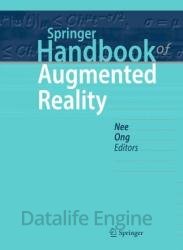 Название: Springer Handbook of Augmented Reality
Название: Springer Handbook of Augmented RealityАвтор: Andrew Yeh Ching Nee, Soh Khim Ong
Издательство: Springer
Год: 2023
Страниц: 919
Язык: английский
Формат: pdf (true)
Размер: 41.9 MB
The Springer Handbook of Augmented Reality presents a comprehensive and authoritative guide to Augmented Reality (AR) technology, its numerous applications, and its intersection with emerging technologies. This book traces the history of AR from its early development, discussing the fundamentals of AR and its associated science.
Augmented Reality (AR) has been a topic of research for decades, but recent commercial interest and investments have made certain forms of AR available to hundreds of millions of users. AR generates the illusion, in real time, of 3D virtual objects appearing to exist in the real world around the user, either supplementing or modifying how users see their surroundings. Unlike Virtual Reality, which completely replaces what a user sees with a purely virtual 3D environment, AR retains the user’s view of the real world and modifies or supplements that with 3D digital objects and information. AR offers a new paradigm of how people view and interact with both digital information and the reality around them. It enables new interfaces and experiences that require combining real and virtual. It can provide the experience of having “supersenses,” where a person can see, hear, and otherwise sense things that were previously invisible and undetectable. The long-run potential of AR glasses is to replace smartphones as the dominant mobile computing platform. That is why companies are investing billions of dollars today to make these visions a reality.
This handbook provides a detailed introduction to the field of AR, through chapters contributed by many notable researchers and practitioners. The first two chapters set the context by describing AR itself and the history of the field. Chapters 3–8 describe key algorithms needed to build effective AR systems, including tracking, mapping, and interaction techniques. Chapters 9–12 focus on the hardware of AR systems, including optics, tracking systems, and wearable devices. Chapters 13–20 introduce many different consumer usages, including gaming, education, theatrical performances, museums, and tourism. However, the first usages that were explored for AR were enterprise usages, such as the maintenance and repair of complex equipment, medical usages, and military applications. Chapters 21–27 cover many of these enterprise usages, while Chaps. 28–31 focus on medical and health applications. Finally, many people are excited about the concept of the “metaverse,” as an open, interoperable virtual 3D world that replaces the digital platforms we use today. A specific type of metaverse is a “mirror world” that is a Digital Twin of the real world, at 1:1 scale, where the Internet of Things enables the real-time digitization and connection between reality and its Digital Twin. AR will be the interface to these mirror worlds, so it is a key technology for making this type of metaverse successful. Chapters 32–35 describe this emerging vision of the future.
The handbook presents a comprehensive reference on AR technology from an academic, industrial and commercial perspective, making it an invaluable resource for audiences from a variety of backgrounds.
Скачать Springer Handbook of Augmented Reality
[related-news] [/related-news]
Комментарии 0
Комментариев пока нет. Стань первым!















